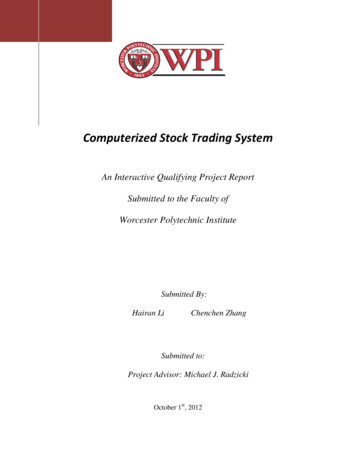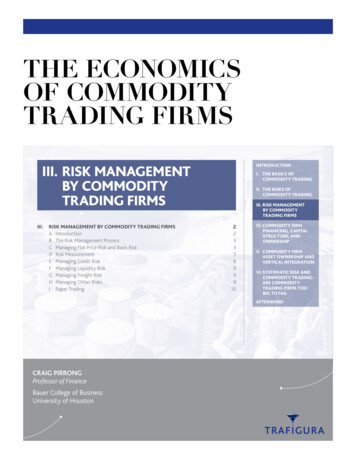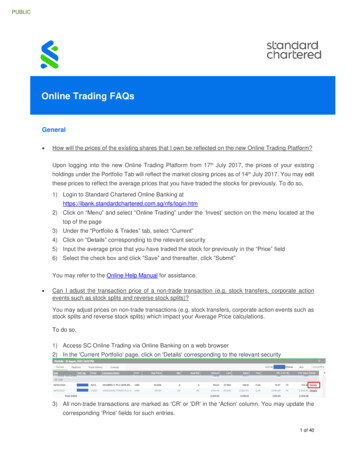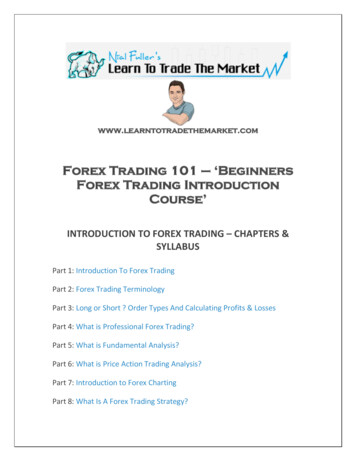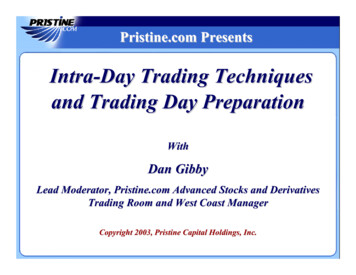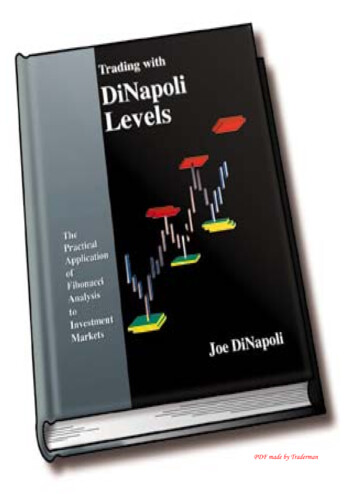
Transcription
Federal Reserve Bank of New YorkStaff ReportsAlternative Trading Systems in theCorporate Bond MarketMatthew KozoraBruce MizrachMatthew PeppeOr ShacharJonathan SokobinStaff Report No. 938August 2020This paper presents preliminary findings and is being distributed to economistsand other interested readers solely to stimulate discussion and elicit comments.The views expressed in this paper are those of the authors and do not necessarilyreflect the position of the Federal Reserve Bank of New York or the FederalReserve System. Any errors or omissions are the responsibility of the authors.
Alternative Trading Systems in the Corporate Bond MarketMatthew Kozora, Bruce Mizrach, Matthew Peppe, Or Shachar, and Jonathan SokobinFederal Reserve Bank of New York Staff Reports, no. 938August 2020JEL classification: G14, G23, G28AbstractWe investigate the trading of corporate bonds on alternative trading system (ATS) platforms. Wedraw a key distinction between request-for-quote (RFQ) and electronic communication network(ECN) trading protocols, which balance investors’ preference for immediacy and anonymity.Trades on ATS platforms are smaller and more likely to involve investment-grade bonds. Tradeson ATS platforms are more probable for older, less actively traded bonds from smaller issues andfor bonds traded by more dealers where inventory is high. Moreover, dealer participation on ATSplatforms is associated with lower customer transaction costs of between 24 and 32 basis points.Key words: corporate bonds, TRACE, electronic tradingShachar (corresponding author): Federal Reserve Bank of New York (email:or.shachar@ny.frb.org). Kozora, Sokobin: FINRA. Mizrach: Rutgers University, FINRA. Peppe:University of Maryland, FINRA (email: ChiefEconomist@finra.org). The authors gratefullyacknowledge the helpful comments provided by Patrick Geraghty, staff from FINRA’s Office ofGeneral Counsel, staff from FINRA’s Transparency Services Department, Bill Vulpis, TedBragg, Kristen Maher, and seminar participants of the 2017 FINRA Economic AdvisoryCommittee Meeting. The views expressed in this paper are those of the authors and do notnecessarily represent the position of FINRA, the authors’ colleagues on FINRA staff, the FederalReserve Bank of New York, or the Federal Reserve System.To view the authors’ disclosure statements, visithttps://www.newyorkfed.org/research/staff reports/sr938.html.
Executive SummaryWe investigate the trading of corporate bonds on alternative trading system (ATS) platforms.Most ATS provide at least one of the two most common electronic trading protocols. The first isthe request-for-quote (RFQ) protocol in which platforms solicit bids and offers whichcounterparties can meet. The second type are automated matching systems which provideimmediately executable liquidity. We refer to this method as the electronic communicationnetwork (ECN) protocol. The usage of these electronic trading protocols, which have not beencomprehensively studied before in the context of the corporate bond market, can improve pretrade transparency and price discovery in the corporate bond market. In this paper, we assess thetypes of securities that trade more frequently on ATS platforms and in each type of protocol, andestimate the impact of ATS platforms on transaction costs.Adoption of electronic trading in corporate bonds has been slower in the U.S. than for other assetclasses, as noted by the BIS (2016). In this paper, we first analyze the corporate bond transactionson electronic platforms that are registered as an ATS in the U.S. Trades on these platforms areflagged in FINRA’s Trade Reporting and Compliance Engine (TRACE), but TRACE does notcollect information on the protocol used. As of December 2017, 16 ATS platforms reportedcorporate bond trades to TRACE. On average, the monthly trading volume on ATS platformsrepresents 2.1% of the total corporate bond market volume and 16.1% of trades. The percentageof dealers (40.5%) and bonds (56.4%) trading on ATS platforms, however, suggest that ATSplatforms cover a large segment of traded bonds.ATS platforms primarily facilitate smaller trades. The median trade size reported on ATSplatforms is 15,000, compared to 35,000 across all reported trades. In addition, only 2.0% oftrades on ATS platforms are 1 million or more, compared to 14.5% in the total market.Investment grade bonds are more likely to trade on an ATS platform, as well as older, less activelytraded bonds from smaller issues. Bonds traded by more dealers, or bonds with higher inventorylevels, are also more likely to trade on an ATS platform. Bonds with these characteristics are alsomore likely to trade on ATS platforms that have received an exemption from some reportingobligations under Rule 6732 than ATS platforms that have not received such an exemption.Comparing customer-to-customer bond transaction chains that include at least one interdealertrade while controlling for other bond and trade characteristics, we find that dealer participationon ATS platforms is associated with lower customer transaction costs of between 24 and 32 basispoints, depending on the specification of the regression model.1
Section 1. IntroductionIn the last 20 years, electronic trading networks have evolved to bring together marketparticipants, facilitate price discovery, and provide liquidity across a variety of asset classes.Relative to other asset classes, market participants have been slow to adopt the new technologiesfor the trading of corporate bonds, and they continue to trade predominantly on bilateral voiceover-the-counter (OTC) markets (BIS (2016)).1 In this paper, we first describe the different typesof electronic trading protocols available to participants in the current corporate bond market.Then we focus on trading on ATS platforms, where we can measure trading probabilityconditioned on characteristics of the corporate bond, and the impact on transaction costs.Electronic trading takes many forms. The majority of electronic corporate bond volume ispursuant to request-for-quote (RFQ) protocols.2 Similar to voice OTC trading, RFQ protocolsenable participants seeking liquidity to broadcast, usually anonymously, buying or selling interestto select other participants. The quotes participants submit in response to the request are for thesoliciting party only, and expire at the end of the session. The quotes may or may not be bindingdepending on the specifics of the trading protocol (SIFMA (2016)).Alternatively, market participants may utilize other protocols offered by ATS platforms thataggregate and match the orders of multiple buyers and sellers using established, nondiscretionary methods for matching.Electronic limit order books, with firm quotes whereparticipants can receive an immediate execution, are a prominent subset of such protocols. Asthese protocols are similar to the ECNs in the U.S. equity and Treasury markets, we will refer tothis subset of protocols as ECN protocols. It has been suggested that the protocols, which havenot been comprehensively studied before, have the potential to improve pre-trade transparencyand price discovery in the corporate bond market through the consolidation and display of orders(Harris, Kyle, and Sirri (2015)).Electronic trading platforms’ offerings are not limited to one type of trading protocol, and manytrading platforms offer more than one trading protocol. For example, electronic platforms canoffer both RFQ trading protocols and ECN trading protocols (SIFMA (2016)).The predominance of RFQ protocols over other protocols may reflect the potential for additionalcosts for participants if they were to seek liquidity through an ECN protocol. Participants seekingliquidity may have additional exposure to information leakage and adverse selection when routingorders pursuant to an ECN protocol. The costs depend on the characteristics of the tradingprotocol, including the number of participants that can view or execute the order and the lengthof time that the orders are actionable. For these reasons, market participants seeking liquiditymay prefer to route orders using an RFQ protocol rather than an ECN protocol.We first investigate trading activity at the level of the electronic ATS platform. For this analysis,we use the information reported to TRACE. With the TRACE data, we can identify all corporatebond trades on registered ATS platforms, but not the type of the trading protocol through whichthe trade was executed. This analysis focuses on the market shares of competing platforms overInternationally, BIS (2016) reports that approximately 40% of investment grade corporate bonds andover 20% of high yield corporate bonds trade electronically. Corporate bonds had the least amount ofelectronic trading of any of the security classes considered in the report (e.g., U.S. Treasuries).1See infra note 13 and related discussion. This finding relies on self-reported figures for volume on nonATS electronic platforms.22
time. The sample period begins in August 2016 after the second of two regulatory changes thatenable us to identify all trades on ATS platforms. The sample period ends in December 2017.As of December 2017, 16 ATS platforms report corporate bond trades to TRACE. Trading on ATSplatforms represents 2.1% of the average monthly trading volume and 16.1% of average monthlytrades in the corporate bond market, with the majority of trades between dealers. The number ofdealers and bonds that trade on ATS platforms, however, suggest that ATS platforms cover a largesegment of the overall market. For example, 353.9 dealers (40.5%) and 11,719.5 bonds (56.4%)that trade in a given month have at least one trade executed and reported on an ATS platform.Dealers who trade on an ATS platform are larger, with reported trading volume 18.9 times greaterthan dealers not reporting an ATS trade. Trading on ATS platforms, however, is not dominatedby large dealers; the ten largest dealers account for a smaller share of ATS platform tradingvolume (42.3%) than OTC market trading volume (58.7%). A dealer is more likely to trade on anATS platform when the aggregate dealer inventory for the bond being traded has recentlyincreased, suggesting ATS platforms are used to manage excess inventory. Bonds trading on anATS platform have on average 2.7 times greater trading volume than bonds not trading on an ATSplatform.Although ATS platforms may reduce search costs by providing easier access to other traders,market participants may also face a higher risk of information leakage and adverse selection whenattempting to trade on these venues. As a result of this trade-off, market participants should bemore likely to trade on an ATS platform in situations where these risks are less important.Consistent with this view, we find that proxies of such risks are associated with less trading onATS platforms. For example, information leakage is likely less of a concern for the liquidity seekerwhen attempting to make a smaller trade. We find that the median trade size on ATS platformsis 15,000 and only 2.0% of trades are 1 million or more. In addition, Han and Zhou (2013)show that information asymmetry and adverse selection are larger for high yield than forinvestment grade bonds. We find that 73.4% of corporate bonds that trade on ATS platforms areinvestment grade, compared to 66.2% of the total market. A multivariate analysis confirmsinvestment-grade bonds are more likely to trade on ATS platforms controlling for othercharacteristics.Search costs are higher when investors have more difficulty finding counterparties. ATSplatforms can reduce search costs by providing easier access to more counterparties. Empirically,we find that bonds of smaller issue size and older vintage are more likely to trade on an ATSplatform. This is true both unconditionally and when controlling for other characteristics.Controlling for other characteristics, bonds with lower recent trading volume are more likely totrade on ATS platforms. Together, these results suggest that ATS platforms are particularly usefulfor bonds where finding a counterparty is more difficult.The size of trades and the characteristics of the bonds differ between ATS platforms that havereceived an exemption from some of their TRACE reporting obligation under FINRA Rule 6732(6732 ATSs) and those ATS platforms that have not received an exemption (non-6732 ATSs).Where an exception has been granted, a 6732 ATS does not have a reporting obligation for tradesthat meet the conditions in the rule.3 An exemption under FINRA Rule 6732 simplifies the3 Trades subject to the exemption must be between FINRA members, not pass through any ATS account,not involve the ATS exchanging securities or funds on behalf of subscribers, and the ATS must not takeeither side of the trade for clearing or settlement purposes. The ATS must provide FINRA data onexempted trades on a monthly basis, remit to FINRA a transaction reporting fee for the exempt trades,and enter into written agreements with the members trading requiring them to report the trade and3
reporting obligations for an ATS platform, lowering the regulatory burden of reporting trades andso requesting an exemption may be more worthwhile for a platform with a larger number oftrades. As of the end of 2017, four ATS platforms have filed for and received an exemption underthis Rule. Platforms that have received exemption may not rely on it for the majority of theirtrades.The four 6732 ATSs facilitate the majority of trades on ATS platforms, and the trading patternswe observe across all ATS platforms predominantly reflect the trades on 6732 ATSs. 6732 ATSsdiffer along a number of dimensions from non-6732 ATSs. For example, a larger number ofdealers and bonds trade on 6732 ATSs than non-6732 ATSs. Similarly, trades on 6732 ATSs aresmaller, with a median trade size of 15,000 compared to a median trade size on non-6732 ATSsof 500,000.4 The clientele of the platforms also appear to differ. For example, nearly all tradingby discount retail brokerages on ATS platforms is on 6732 ATSs.Next, we estimate the potential gains to customers from dealer participation on ATS platforms.Using a methodology similar to Li and Schürhoff (2018), we identify sequences of trades thatbegin with a customer sale and end with a customer purchase (i.e., trade chains). For the tradechains with an interdealer trade, we compare customer transaction costs between the chains thatinclude and do not include a dealer transaction on an ATS platform. Holding the length of thetrade chain constant, we estimate that a trade on an ATS platform is associated with lowercustomer transaction costs of between 24 and 32 basis points. As a way to assess the relativeimportance of the difference in transaction costs, the average customer transaction cost in oursample is 115 basis points.Overall, the results of this paper indicate the economic importance of and trade-offs associatedwith ATS platforms and the protocols they offer in today’s market. ATS platforms seem to be apreferred venue when information leakage is a lesser concern, such as for small trades ininvestment grade corporate bonds. Market participants may prefer other venues where the costsassociated with information leakage are more significant. These result are similar to Hendershottand Madhavan (2015). In contrast to Hendershott and Madhavan (2015), however, our resultsindicate that ATS platforms are more likely to facilitate trades for older, smaller issues wherelocating a counterparty may be more difficult.Our sample incorporates a larger number of electronic trades in our analysis than the study byHendershott and Madhavan (2015) due to the larger number of platforms in our sample and theincrease in electronic trading that has occurred over time. Hendershott and Madhavan (2015)study approximately 29,000 electronic trades per month between January 2010 and April 2011.With the TRACE data, we study approximately 225,000 electronic trades on ATS platforms permonth. Our sample also encompasses platforms offering ECN protocols more similar toelectronic trading for equities than the RFQ platform studied by Hendershott and Madhavan(2015).The remainder of the paper is organized as follows. In Section 2, we provide backgrounddescribing electronic trading in corporate bonds and TRACE reporting obligations of FINRAmembers. We describe the sample data in Section 3 and demonstrate the effect of recentidentify it as taking place on the ATS. See rarules/6732.In the analysis measuring customer costs, we are able to identify few trade chains with a trade on a non6732 ATS. The reduction in customer costs, therefore, reflect the trades on 6732 ATSs.44
regulatory changes on our ability to identify the trades on ATS platforms in the TRACE data. Weexamine the trading on ATS platforms in Section 4, and we examine the relationship betweenATS platform use and customer transaction costs in Section 5. Section 6 concludes.Section 2. BackgroundIn this section, we describe the different venues for the trading of corporate bonds (i.e., voice OTCmarkets, RFQ protocols, and ECN protocols), and the factors that may influence its selection bymarket participants. We also describe the reporting obligations of FINRA members to TRACE.2.1 Choice of Trading VenueCorporate bonds trade in both voice OTC and electronic markets. The choice of trading venuemay impact the likelihood of a transaction, the price obtained, the broker-dealers’ costs to identifya counterparty, the amount of information leakage, and the exposure to adverse selection. Marketparticipants may be particularly sensitive to the choice of venue due to the large number andheterogeneity of corporate bonds, and the infrequency in which many corporate bonds trade.Traditionally, corporate bonds trade in voice OTC markets. In these markets, participants solicitbids, including trade size and price, from one or more participants to purchase or sell a bond.Participants incur costs to conduct the bilateral and sequential solicitation of other participants(Duffie, Gârleanu, and Pedersen (2005)). With the bilateral and sequential solicitation, however,participants can limit the disclosure of their trading intentions and potentially reduce the costsassociated with information leakage.Corporate bonds also trade in electronic markets.5 A majority of electronic corporate bondvolume is executed pursuant to RFQ protocols.6 An RFQ protocol is the electronic equivalent ofa voice OTC market. Participants seeking liquidity (initiators) can solicit bids or offers, includingtrade size and price, to purchase or sell a bond from other participants (respondents). Unlike thevoice OTC markets, initiators can broadcast buying or selling to more than one participantsimultaneously. Although initiators reduce their costs to search for a trading counterparty, thesimultaneous broadcast can increase the amount of information leakage. Respondents are underno obligation to respond to a solicitation, and the quotes respondents submit are for the solicitingparty only. Quotes can be open for negotiation, and expire at the end of the session. Initiatorshave discretion over whether or not to trade after receiving quotes, and respondents generallymake a binding second commitment before confirmation.7Hendershott and Madhavan (2015) model the choice of trading venue between RFQ protocols andvoice OTC markets. Their model describes the choice of venue as a tradeoff between an increasein dealer price competition and an increase in the cost of information leakage. Although an RFQElectronic trading in the corporate bond market greatly increased in the early 2000s. -of-electronic-bond-platforms. See SIFMA (2016) fora description of the existing electronic platforms for the trading of U.S. corporate and municipal securities.56See infra note 14 and related discussion.7 An initiator that executes a trade may receive information regarding the second best price (i.e., the “coverprice”). The disclosure of the cover price, however, may be dependent on the parties to the trade. Forexample, see es-idUSKBN1I528W.5
protocol increases dealer competition, resulting in better bond prices, the simultaneous disclosureof trading intentions to multiple participants increases the cost from information leakage. Theyfind empirical results consistent with their model; RFQ protocols facilitate the trades of corporatebonds when participants are more likely to respond to a request and participants are likely toincur fewer costs from information leakage.ATS platforms offer a variety of protocols that bring together the orders of multiple buyers-andsellers and use established, non-discretionary methods to match those orders. The majority oftrading on the most active ATS platforms takes place via ECN protocols that involve a live andexecutable order book.8 Participants seeking liquidity via ECN protocols may have additionalexposure to information leakage but may also benefit from increased price competition whenplacing orders. Participants who place non-marketable limit orders provide a free option to theother participants to trade at the posted quote (Hendershott and Madhavan (2015)). The cost ofthe free option increases with the number of participants that may execute the order and thelength of time the orders are live and executable. The additional exposure to information leakageand the cost of keeping quotes for many instruments current are possible explanations for thepredominance of electronic trading executed pursuant to RFQ protocols.Another protocol offered by some ATS platforms is session trading where orders are submitted,matched, and then executed. Session trading is generally not continuously available, occurring atpre-defined times or triggered by a trade through another protocol, and typically occurs at pricesprovided by a third party or at a midpoint of indications of interest.Trading protocols can also vary among other dimensions which can impact the potential costs totrade. For example, protocols may offer the ability of participants to specify who receives arequest-for-quote or views their orders. This feature may reduce the likelihood of transaction orthe probability that best price is received, but also can reduce the potential adverse selection ofthe participants seeking liquidity. Trades may also be subject to a “last look” where the liquidityprovider has a final opportunity to confirm or deny an attempt to trade at a price it quoted. Thisreduces the risk of adverse selection for the liquidity provider but may increase the risk of adverseselection and information leakage for the responding party. Some platforms set a minimum sizerequirement for trades.The method of trading, as well as the information, bargaining power, and preference forimmediacy and anonymity, will factor into a participant’s choice of trading venue. Another factoris the amount of available liquidity. Pagano (1989) shows that because the depth and liquidity ofa market depends on the entry decisions of all potential participants, and when transaction costsare otherwise equal, trading will tend to concentrate where participants expect others to sendtheir orders. The selection of trading venues with more liquidity by market participants isconsistent with the empirical evidence; although the total number and market share of electronicplatforms have increased over time, trading appears to concentrate on few platforms. The successof electronic trading platforms is dependent on gaining traction among participants. Electronictrading platforms that enter the market may attempt to compete for market share with theexisting platforms by offering new technology innovation or targeting a specific segment of themarket.Conversations with several of the four 6732 ATSs indicate a majority of their trades are pursuant to suchprotocols.86
2.2 TRACE ReportingTRACE facilitates the mandatory reporting and dissemination of OTC market transactions inorder to assist price discovery and improve execution quality. Securities eligible for TRACEreporting are U.S. dollar-denominated debt securities issued by a domestic or foreign privateissuer (other than restricted securities that are not sold pursuant to Rule 144A), issued orguaranteed by an executive agency or Government-Sponsored Enterprise, or issued by the U.S.Department of Treasury.9Each FINRA member that is a party to a reportable transaction in a TRACE-eligible security hasa reporting obligation.10 Member firms that act as an introducing or executing broker-dealer areconsidered a party to a transaction, and therefore have a reporting obligation. Non-members,including customers and non-member affiliates of member firms, do not have a reportingobligation. A trade report includes the security identifier, date, time, size (par value), and priceof the transaction. A report also identifies the member firm’s side of the transaction (buy or sell),their capacity as a principal or agent, and the other parties to the transaction. The requiredreporting time varies between categories of TRACE-eligible securities. Member firms must reporta secondary corporate bond transaction as soon as practicable, but no later than within 15 minutesof the time of execution.Electronic platforms may or may not have a reporting obligation. The reporting obligation of anelectronic platform is dependent on whether the platform is a party to the trade. Some electronicplatforms are registered as ATSs.11 An ATS platform is a party to all transactions executed throughits system, and therefore has a reporting obligation.12 An ATS platform is a party to every traderegardless of whether the trade is pursuant to an ECN protocol or to another protocol (e.g., RFQprotocol).An electronic platform that is not an ATS is not necessarily a party to all trades executed throughits system so may not always have a reporting obligation.13 One circumstance where an electronic9See FINRA Rule 6710.A transaction in a TRACE-eligible security is reportable unless an exception applies. Exceptions includethe sale from an issuer to an underwriter or initial purchaser, a transfer for the sole purpose of creating orredeeming an instrument (e.g., an exchange-traded fund), and a transaction resulting from the exercise orsettlement of an option or a similar instrument. See FINRA Rule 6730.1011 In general, a trading platform that meets the SEC’s functional definition of an “exchange” must registeras a national securities exchange or comply with Regulation ATS, which requires registration as a brokerdealer. See Securities and Exchange Commission, Regulation of Exchanges and Alternative TradingSystems, Release No. 34-40760.See FINRA Regulatory Notice 14-53. For a trade between two counterparties, an ATS separately reportsa purchase of securities from the first counterparty and a sale of securities to the second counterparty. AnATS may also involve a third-party intermediary that provides clearance and settlement services. Thethird-party intermediary is a party to the trade and also has a reporting obligation. The presence of athird-party intermediary, however, does not absolve the ATS from its reporting obligations.1213 Two such electronic platforms are operated by Bloomberg L.P. (Bloomberg) and MarketAxessCorporation (MarketAxess). Bloomberg’s electronic fixed-income trading platforms are operated outsideof its registered broker-dealer, Bloomberg Tradebook LLC, which was previously subject to Regulation ATSbut not for trading of corporate bonds and ceased operating its ATS in September 2016. MarketAxess isregistered as a broker-dealer and subject to Regulation ATS, but not for the trading of corporate bonds. In7
platform that is not an ATS would be a party to a trade through its platform and thus have areporting obligation is if the platform takes a side to a trade. This may occur when counterpartieson the platform remain anonymous through execution and the platform acts as a risklesscounterparty to both sides of the trade. In order to facilitate this type of interaction on an RFQplatform, the operator would be required to establish a FINRA-registered broker-dealer to serveas the riskless counterparty. The intermediating broker-dealer would have TRACE reportingrequirements.Two recent changes to the TRACE reporting obligations of ATSs greatly increased our ability toidentify trades on electronic platforms. We discuss the regulatory changes in further detail in thenext section, and demonstrate their effect on our ability to identify trades on ATS platforms.Section 3. DataWe use the supervisory version of TRACE data to document the extent of trading on ATSplatforms, the characteristics of the bonds that trade on them, and the differences in transactioncosts between trade chains that involve an ATS platform trade and those that do not. We alsocompare the trades on ATS platforms to the trades off ATS platforms.3.1 OverviewThe primary dataset that we use in the analysis is the supervisory version of TRACE data. Similarto the academic version of TRACE data, the supervisory version identifies FINRA members witha unique identifier.14 The supervisory version, however, identifies member firms uniquely withtheir Market Participant Identifier (MPID). Non-member affiliates of member firms (affiliates)are identified with an “A,” and customers of member firms are identified with a “C.” The academicversion also provides transaction-level data on a 36-month delayed basis, whereas the supervisoryversion does not have a similar delay.The supervisory version also does not censor the total par value of the trade. The real-time publicversion of TRACE data disseminates investment grade bond trades greater than 5 million as“5MM ,” and high-yield or unrated bond trades grea
Trading on ATS platforms, however, is not dominated by large dealers; the ten largest dealers account for a smaller share of ATS platform trading volume (42.3%) than OTC market trading volume (58.7%). A dealer is more likely to trade on an ATS platform when the aggregate dealer inventory for the bond being traded has recently





